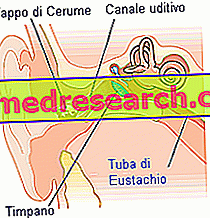Generality
Perforation of the eardrum consists in tearing the thin tympanic membrane that separates the external auditory canal from the middle ear. This rupture leads to a reduction in hearing capacity (hypoacusis) and, if it occurs suddenly, triggers a sharp pain in the affected ear.

A perforated eardrum can cause much discomfort, but if the lesion is small, it heals spontaneously, without specific treatment, within a couple of months. If an infection is present, the doctor may prescribe antibiotics, while painkillers, such as ibuprofen or paracetamol, can relieve pain. Hearing reduction is usually temporary and depends on the location and size of the perforation. If the injury is very severe or does not heal, it may be necessary to have surgery to repair the tympanic membrane (myringoplasty). The complications associated with surgery are rare, but can include infections, hearing loss and dizziness.
Timpano
The eardrum performs two important functions:
1) Conduction of sounds. The ear is divided into three parts: external, middle and internal. The outer ear consists of the auricle and the external auditory canal.

2) Protection barrier . The eardrum separates the external auditory canal from the middle ear, protecting its delicate structures from the entry of pathogens, water and other foreign substances. Perforation of the eardrum makes the middle ear vulnerable and internal to infection or other damage.
Symptoms
In the case of a perforated eardrum, the hearing in the affected ear is partially or completely compromised. The extent of hearing loss depends on the size of the laceration: a small lesion can only cause a slight hearing loss, while more severe damage can cause greater deafness. In general, however, the hearing loss resulting from tympanic perforation is only temporary and hearing is restored once the eardrum has healed.
In addition to hearing loss, a perforated eardrum can cause the following symptoms:
- Sharp and sudden pain in the ear (if the onset is immediate);
- Ear infections, with leakage of blood or purulent or serous secretions from the ear canal;
- Ringing in the ears (tinnitus or tinnitus);
- Facial weakness or dizziness.
Risk of infection
The eardrum represents a protective barrier that prevents germs and bacteria from entering the middle ear. Therefore, in the case of a perforated eardrum increases the risk of developing an infection.
The symptoms of otitis of the middle ear may include:
- Severe ear pain, due to the pressure exerted by the fluids on the eardrum;
- Fever (38 ° C or higher);
- Slight hearing loss.
Signs of infection in children
Children with an ear infection may also develop flu-like symptoms, such as vomiting, increased body temperature and lack of energy.
Other signs of an ear infection in children and infants are:
- Repeated rubbing of the ear;
- Fever (38 ° C or higher);
- Irritability;
- Loss of appetite;
- Nighttime restlessness;
- Cough;
- A runny nose;
- No response to less intense sounds;
- Loss of balance.
Causes
The eardrum can be perforated for several reasons:
- Infection of the middle ear. Middle ear infection is one of the most common causes of tympanic perforation. Otitis media (acute relapsing, effusive, or serum-mucous) can cause fluid accumulation within the ear. If the Eustachian tube, a conduit that connects the middle ear to the pharynx, is closed for inflammation, it can lead to the reflux of infected secretions from the nasopharynx to the middle ear. The purulent or serous material that stagnates in this place can exert pressure on the eardrum until it perforates it; sometimes the amount of fluids is so high that it causes secretions to escape from the external auditory canal.
- Direct traumatic event. The perforation of the eardrum can be caused by a violent trauma to the ear (for example, due to a sports injury, a powerful slap, the impact of an air bag or the accidental penetration of foreign bodies) or by the improper use of an object introduced into the auditory canal (such as forced and deep insertion of washed hygienic sticks). Even severe head injury can cause damage to the inner ear structures, including the eardrum.
- Loud noises. A perforated eardrum can be caused by a sudden and very intense noise; for example, shock waves of a strong explosion can damage sensitive parts of the ear, including the eardrum. Often, perforation of the tympanic membrane caused by a loud noise is manifested by severe hearing loss and the appearance of persistent ringing in the ears (tinnitus).
- Changes in air pressure (barotrauma). A sudden change in pressure often causes ear pain, as happens, for example, due to a change in altitude during a plane trip. Occasionally, failure to compensate for the middle ear compared to the pressure of the external environment may cause the eardrum to break. This can also occur during diving or in other situations where there is a large difference between the surrounding air pressure and the pressure inside the middle ear.
Diagnosis
During the otoscopic examination, the doctor uses an instrument, the otoscope, equipped with a light and a lens; in this way it can examine the inside of the ear and highlight the eventual perforation of the eardrum, the site of the lesion and its dimensions. The audiometric examination can instead assess the extent of hearing reduction.
Treatment
In many cases, a perforated eardrum can heal spontaneously without treatment, in about two months. A possible treatment is mainly aimed at alleviating discomfort and treating or preventing an infection.
Avoid entry of water into the middle ear.
During the healing of a perforated eardrum, it is essential to keep the affected ear dry: in case of penetration of water into the middle ear, pathogens can pass through the lesion and cause infection. For this reason, it is not advisable to go to the pool. During a shower or bath, you can wear a cap over your ears, gently insert a cotton ball coated with Vaseline into your ear or use waterproof earplugs.
Painkillers
Pain caused by a perforated eardrum can be treated with painkillers, such as paracetamol or ibuprofen. To relieve discomfort, you can also try placing a bottle of hot water wrapped in a towel against your ear.
Antibiotics
Your doctor may prescribe antibiotic therapy when the perforation of the eardrum is caused by an infection or when it could develop during healing. Antibiotic ear drops or tablets to be ingested may be prescribed.
Surgery
In case of severe and extensive perforation of the eardrum, recurrent infections of the middle ear and severe hearing loss, it may be necessary to resort to surgery.
Surgery to treat a perforated eardrum can be recommended for:
- Prevent water from entering the middle ear (could cause an infection);
- Reduce the likelihood of ear infections;
- Improve hearing.
The procedure used to repair a perforated eardrum is known as myringoplasty.
The specialist treatment should begin within 18 weeks of the eardrums breaking or perforation. Myringoplasty is a painless microsurgery that allows you to achieve excellent results (the success rate is over 90%). This procedure is synonymous with type 1 tympanoplasty: it involves only the closure of the tympanic perforation, and is therefore indicated when the middle ear has not suffered other lesions. Tympanoplasty, in fact, is classified into 5 approaches, which describe various surgical operations performed to reconstruct the eardrum and / or chain of auditory ossicles in the middle ear.
The myringoplasty is also indicated to restore hearing (in some cases, it also resolves tinnitus) and to avoid re-infection from the external auditory canal and the Eustachian tube.
The intervention is contraindicated in the following cases:
- Active secretion from the middle ear;
- Allergy with nasal congestion, which should be managed before surgery;
- Deafness of the other ear (not affected by perforation);
- Otitis externa;
- Children under the age of 3 years.
The procedure
In the case of myringoplasty, the patient is admitted to the otorhinolaryngology department. Depending on the circumstances, the time required for hospital stay varies from a few hours to a couple of days. The myringoplasty can be performed through the ear canal or by using an incision behind the ear, which allows easier access to the perforated eardrum. During surgery, a graft is performed: the surgeon uses a small portion of tissue taken from the same patient to seal the hole or tear of the tympanic membrane; The grafting materials most commonly used for myringoplasty are the temporal fascia (ie the tissue that covers the temporal muscle), the cartilage and the tragic perichondrium (the tragus is the rectangular lobule that protects the external auditory canal). Alternatively, to cover the perforated eardrum, the surgeon can use a biomaterial.
The procedure is performed under general or local anesthetic. To complete, the myringoplasty takes about an hour, if performed through the ear canal, or two to three hours, if the surgeon uses an incision. After the procedure, a dressing is inserted inside the ear canal and a cotton padding to protect the ear, held in place with a bandage.
Recovery
After surgical repair of the perforated eardrum, the patient needs two weeks of rest.
During this time, they should be avoided:
- Sudden head movements;
- Contact sports or intense physical exercise;
- Lifting of heavy loads.
In addition, the patient should carefully blow the nose to avoid excessive pressure fluctuations. If the surgical incisions have been closed with some stitches, they will be removed after about a week. A myringoplasty should not cause too much pain, but if necessary painkillers can be taken. After two to four weeks from the operation, the dressings can be removed. During the post-operative phase it is important to keep the wounds dry until complete recovery. Finally, it is not advisable to travel by air until the doctor has evaluated the complete recovery of the ear.
Surgery complications
The complications associated with surgery to repair a perforated eardrum are rare, but may include:
- Infection. After surgery, an infection may occur. If the ear is infected, there will be an increase in pain, bleeding and discharges of purulent material.
- Hearing loss. Rarely, if the structures of the inner ear are damaged during surgery, severe deafness can occur.
- Tinnitus (or tinnitus). After the surgical procedure, a persistent ringing in the treated ear may occur.
- Vertigo . For a couple of hours after myringoplasty, vertigo is a common experience. In a small number of cases, these can last longer (even two to three weeks).
- Facial paralysis. The nerve that controls the muscles of the face passes close to the ear, so there is a slight risk of facial paralysis (weakness of the face muscles) following surgery. Sometimes, facial paralysis develops immediately after the procedure. The facial muscles can recover completely or partially.
- Taste. The main nerve responsible for processing the sense of taste (glossopharyngeal nerve or ninth cranial nerve) runs near the ear, so there is a risk that it may be damaged during myringoplasty to repair the perforated eardrum. If this happens, you may experience a strange taste on one side of your tongue.



